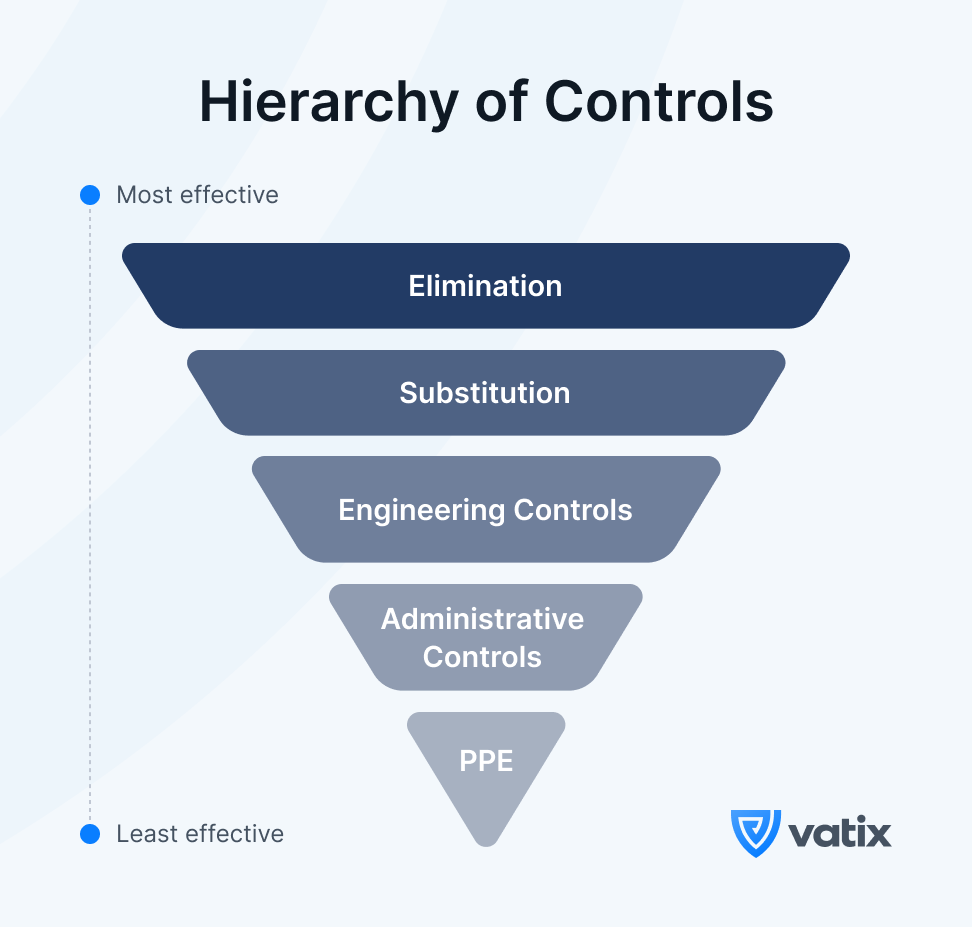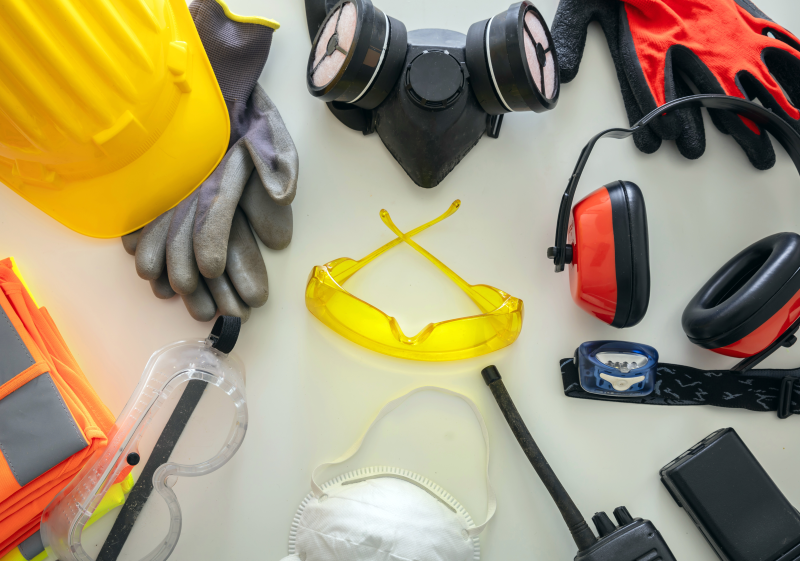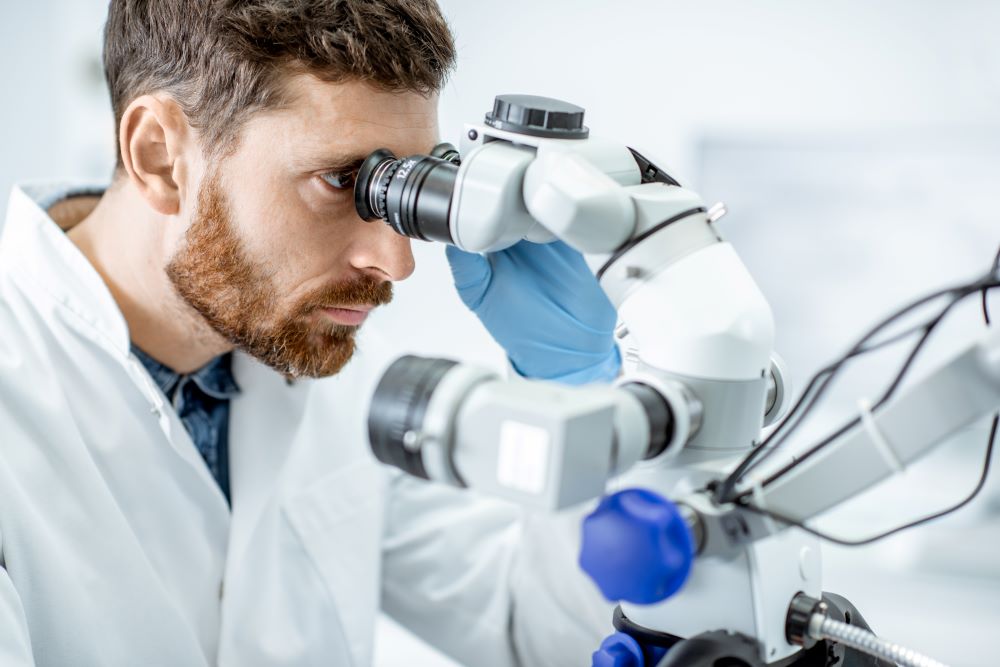How can you best reduce workplace hazards?
The hierarchy of control is a proven method for managing risks and implementing effective safety measures.
In this article, we’ll break down each level of the hierarchy and provide actionable insights on how to integrate these controls into your daily operations for a safer work environment.
What is the Hierarchy of Control?
The Hierarchy of Control was first introduced by the National Safety Council (NSC) in 1950 and has since become a fundamental approach in occupational health and safety management.
This framework was designed to systematically reduce or eliminate workplace hazards by implementing systems or control measures ranked from most effective to least effective. It guides organisations in selecting the most effective measures to control hazards, ensuring safety isn’t left to chance but is a result of careful planning and robust strategies.
The principle that underpins the hierarchy of control is simple yet profound: decrease workers’ exposure to hazards to reduce the risk of harm.
The Five Tiers of Hazard Control
The hierarchy is often depicted as an ‘upside-down pyramid’, visually representing the different controls in order of effectiveness. The higher the control is on the pyramid, the more effective it is at reducing hazards.
Each level of the hierarchy serves a distinct purpose in enhancing workplace safety, offering a unique method for controlling hazards. The goal is to prioritise the most effective control measures and reduce risk to the barest minimum.

The five control methods, starting from the top, are:
Elimination
Substitution
Engineering Controls
Administrative Controls
Personal Protective Equipment (PPE)
Let’s delve further into each of these controls, from the most to least effective at minimising workplace hazards.
1. Elimination
Elimination is the highest tier in the hierarchy of control and represents the most effective control measure for reducing hazards in the workplace.
This method involves completely removing the hazard from the work environment, thereby eliminating the risk of injury or illness associated with it. When a hazard is eliminated, it no longer poses any threat to workers, making this the most reliable and desirable control measure.
Examples:
Removing a hazardous piece of equipment and replacing it with a safer alternative, ensuring that the risk is permanently removed.
Investing in machinery that automates repetitive and hazardous tasks, so that workers are no longer exposed to these risks.
Substituting a chemical-based cleaning agent with a non-toxic one to remove the chemical hazard completely, eliminating the associated health risks.
Prevention through Design (PtD)
A key strategy for hazard elimination is ‘Prevention through Design’ (PtD), which acts as a first line of defence against hazards.
This is a proactive approach that integrates safety into the design process to prevent hazards before they become a problem, minimising the risk of injury or illness in the workplace. It’s about addressing the problem at its root, rather than dealing with its consequences.
By eliminating risks at the design stage, PtD enhances safety, reduces costs, and ensures compliance with safety regulations.
2. Substitution
When elimination is not possible, the next best approach to reduce risk is substitution. This involves replacing hazardous materials, processes, or practices with less dangerous alternatives.
This approach focuses on finding safer equivalents to mitigate potential harm without compromising the effectiveness of the task.
Examples:
Replacing solvent-based paint with water-based paint to minimise hazardous exposure.
Substituting traditional cutting tools, which produce significant noise and dust, with laser cutting technology, which generates less noise and dust. This substitution decreases the risk of hearing loss and respiratory issues, enhancing worker safety and comfort.
Using a cordless drill instead of an electric one to reduce the risk of an electrical hazard.
3. Engineering Controls
Engineering controls are the third tier in the hierarchy of control, focusing on isolating people from hazards through physical modifications to the workplace or equipment.
These control measures are designed to remove or reduce the presence of hazards without relying on worker behaviour, making them more reliable than administrative controls or personal protective equipment (PPE).
Engineering controls can mitigate noise, falls, and exposure to dangerous substances. While they may not eliminate hazards completely, engineering controls serve as a physical barrier to isolate people from risks and are particularly implemented when hazards cannot be completely removed or substituted.
Isolation Techniques
Isolation techniques systematically reduce risks by separating workers from hazards.
These techniques involve the use of barriers, enclosures, and guards to isolate equipment and protect workers from hazards.
Examples:
Installing protective barriers such as machine guarding to prevent workers from coming into contact with moving parts.
Utilising remotely controlled equipment, allowing for the operation of machines while maintaining a safe distance from the hazard, reducing the potential for worker exposure and injury.
Ventilation Systems
Ventilation systems are another form of engineering control. They are designed to reduce the presence of hazardous dust, fumes, or gases in the workplace.
Examples:
Using fume hoods in laboratories to contain hazardous vapours and prevent them from reaching the worker.
Implementing local exhaust ventilation systems that capture dust and fumes at the source, preventing respiratory exposure and keeping the work environment clean.
4. Administrative Controls
Administrative controls are the fourth tier in the hierarchy of risk control and focus on changing the way people work to reduce exposure to hazards.
These controls involve implementing policies, procedures, training, and supervision to promote safe practices and minimise risks.
While not as effective as elimination, substitution, or engineering controls, administrative control measures enhance safety by ensuring workers follow company safety procedures for tasks like handling hazardous materials or working at heights, under proper supervision to guarantee compliance.
Examples:
Conducting regular safety training sessions to educate employees about potential hazards and proper safety measures.
Implementing job rotation to limit the time workers spend on repetitive or strenuous tasks, reducing the risk of musculoskeletal disorders.
Posting warning signs around high-voltage areas and using alarm systems to indicate when safety protocols are breached.
Organisational Changes
Organisational changes are vital for effectively managing health and safety risks. For instance, completing a risk assessment for every work order is a strategic move to highlight risks and manage them proactively within administrative controls.
By reconfiguring incident management processes with a focus on employing software solutions, organisations ensure that more emphasis is placed on higher-order controls to improve responses to serious incidents.
These changes help in fostering a culture of safety and proactive risk management within organisations.
5. Personal Protective Equipment (PPE)
Personal Protective Equipment (PPE) is the final component in the hierarchy of controls.
It serves as the last line of defence against workplace hazards and should be used when other methods aren’t feasible or are still being developed.
While PPE is crucial for protection, it is considered the least reliable control compared to other control measures because it relies on proper usage and does not eliminate the hazard itself. Effective use of PPE requires proper selection, fitting, training, and maintenance to ensure maximum protection.

PPE comprises various items such as:
Ear plugs
Goggles
Face masks
Respirators
Gloves
Aprons
Safety harnesses
Bodysuits
While these items don’t eliminate the hazards, they act as a physical barrier, protecting workers from potential harm and reducing their exposure to hazards.
Compliance and Maintenance
Providing PPE is not enough; employers also have the legal obligation to ensure that workers are trained to use it properly and that the equipment is maintained and replaced as necessary. Compliance with PPE standards includes:
Training workers on how to properly use and wear PPE
Regularly inspecting and maintaining PPE to ensure it is in good working condition
Replacing PPE when it becomes damaged or worn out
By following these guidelines, employers can increase the level of safety and reduce liability risks.
Integrating Control Measures for Comprehensive Protection
The hierarchy of control is not a choose-one-and-ignore-the-rest kind of system.
In fact, integrating different levels of control measures leads to more effective management of workplace risks. Doing so reduces the physiological effort required by workers and provides comprehensive protection against hazards.
A combination of controls should be employed if no single method offers full protection to workers. And while doing so, it’s crucial to ensure that the selected control measures don’t introduce new hazards.
Risk Assessments
The risk assessment process is a crucial step in implementing the hierarchy of control.
It’s a thorough process that examines all aspects of the workplace for potential sources of harm, evaluates the likelihood and severity of potential harm, and identifies current measures in place to mitigate these risks.
Reviewing the controls regularly is vital to ensure they remain effective and to make adjustments in response to any changes in the workplace or after incidents have occurred.

How Can We Help?
Effective incident management is crucial for implementing the hierarchy of control by ensuring that hazards are identified, assessed, and mitigated promptly and efficiently.
Vatix’s incident reporting software supports this process by providing a centralised platform for reporting and managing incidents and near misses.
With instant notifications to relevant staff and the assignment and monitoring of corrective actions following an incident, organisations can ensure that root causes are addressed swiftly and effectively.
The comprehensive analytics dashboard offers valuable insights into patterns and high-risk areas, essential for developing effective control measures.
For more information on how Vatix can help your organisation effectively manage workplace risks, talk to our sales team here.

